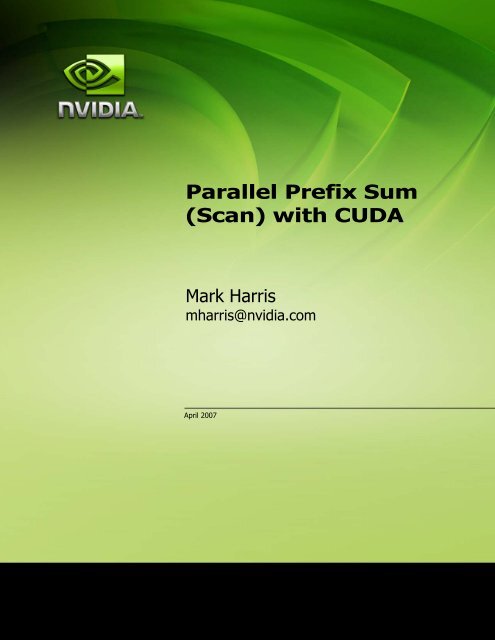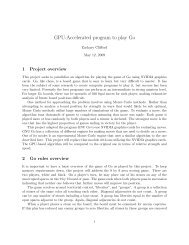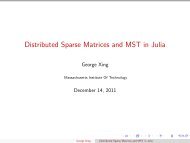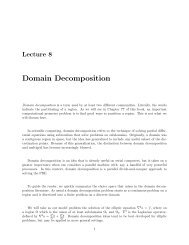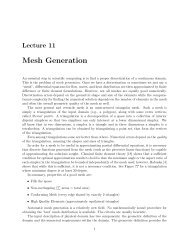Parallel Prefix Sum (Scan) - Applied parallel Computing - MIT
Parallel Prefix Sum (Scan) - Applied parallel Computing - MIT
Parallel Prefix Sum (Scan) - Applied parallel Computing - MIT
You also want an ePaper? Increase the reach of your titles
YUMPU automatically turns print PDFs into web optimized ePapers that Google loves.
<strong>Parallel</strong> <strong>Prefix</strong> <strong>Sum</strong><br />
(<strong>Scan</strong>) with CUDA<br />
Mark Harris<br />
mharris@nvidia.com<br />
April 2007
Document Change History<br />
Version Date Responsible Reason for Change<br />
February 14,<br />
2007<br />
Mark Harris<br />
Initial release<br />
April 2007<br />
ii
Abstract<br />
<strong>Parallel</strong> prefix sum, also known as <strong>parallel</strong> <strong>Scan</strong>, is a useful building block for many<br />
<strong>parallel</strong> algorithms including sorting and building data structures. In this document<br />
we introduce <strong>Scan</strong> and describe step-by-step how it can be implemented efficiently<br />
in NVIDIA CUDA. We start with a basic naïve algorithm and proceed through<br />
more advanced techniques to obtain best performance. We then explain how to<br />
scan arrays of arbitrary size that cannot be processed with a single block of threads.<br />
Month 2007 1
<strong>Parallel</strong> <strong>Prefix</strong> <strong>Sum</strong> (<strong>Scan</strong>) with CUDA<br />
Table of Contents<br />
Abstract.............................................................................................................. 1<br />
Table of Contents............................................................................................... 2<br />
Introduction....................................................................................................... 3<br />
Inclusive and Exclusive <strong>Scan</strong> .........................................................................................................................3<br />
Sequential <strong>Scan</strong>.................................................................................................................................................4<br />
A Naïve <strong>Parallel</strong> <strong>Scan</strong> ......................................................................................... 4<br />
A Work-Efficient <strong>Parallel</strong> <strong>Scan</strong>........................................................................... 7<br />
Avoiding Bank Conflicts ...................................................................................11<br />
Arrays of Arbitrary Size....................................................................................14<br />
Performance.....................................................................................................16<br />
Conclusion........................................................................................................17<br />
Bibliography.....................................................................................................18<br />
April 2007 2
<strong>Parallel</strong> <strong>Prefix</strong> <strong>Sum</strong> (<strong>Scan</strong>) with CUDA<br />
Introduction<br />
A simple and common <strong>parallel</strong> algorithm building block is the all-prefix-sums operation. In<br />
this paper we will define and illustrate the operation, and discuss in detail its efficient<br />
implementation on NVIDIA CUDA. As mentioned by Blelloch [1], all-prefix-sums is a<br />
good example of a computation that seems inherently sequential, but for which there is an<br />
efficient <strong>parallel</strong> algorithm. The all-prefix-sums operation is defined as follows in [1]:<br />
Definition: The all-prefix-sums operation takes a binary associative operator ⊕, and an array of n<br />
elements<br />
[a 0 , a 1 , …, a n-1 ],<br />
and returns the array<br />
[a 0 , (a 0 ⊕ a 1 ), …, (a 0 ⊕ a 1 ⊕ … ⊕ a n-1 )].<br />
Example: If ⊕ is addition, then the all-prefix-sums operation on the array<br />
[3 1 7 0 4 1 6 3],<br />
would return<br />
[3 4 11 11 14 16 22 25].<br />
There are many uses for all-prefix-sums, including, but not limited to sorting, lexical analysis,<br />
string comparison, polynomial evaluation, stream compaction, and building histograms and<br />
data structures (graphs, trees, etc.) in <strong>parallel</strong>. For example applications, we refer the reader<br />
to the survey by Blelloch [1].<br />
In general, all-prefix-sums can be used to convert some sequential computations into<br />
equivalent, but <strong>parallel</strong>, computations as shown in Figure 1.<br />
out[0] = 0;<br />
forall j from 1 to n do<br />
out[j] = out[j-1] + f(in[j-1]);<br />
forall j in <strong>parallel</strong> do<br />
temp[j] = f(in[j]);<br />
all_prefix_sums(out, temp);<br />
Figure 1: A sequential computation and its <strong>parallel</strong> equivalent.<br />
Inclusive and Exclusive <strong>Scan</strong><br />
All-prefix-sums on an array of data is commonly known as scan. We will use this simpler<br />
terminology (which comes from the APL programming language [1]) for the remainder of<br />
this paper. As shown in the last section, a scan of an array generates a new array where each<br />
element j is the sum of all elements up to and including j. This is an inclusive scan. It is often<br />
useful for each element j in the results of a scan to contain the sum of all previous elements,<br />
but not j itself. This operation is commonly known as an exclusive scan (or prescan) [1].<br />
Definition: The exclusive scan operation takes a binary associative operator ⊕ with identity I, and an<br />
array of n elements<br />
[a 0 , a 1 , …, a n-1 ],<br />
April 2007 3
<strong>Parallel</strong> <strong>Prefix</strong> <strong>Sum</strong> (<strong>Scan</strong>) with CUDA<br />
and returns the array<br />
[I, a 0 , (a 0 ⊕ a 1 ), …, (a 0 ⊕ a 1 ⊕ … ⊕ a n-2 )].<br />
Example: If ⊕ is addition, then the exclusive scan operation on the array<br />
[3 1 7 0 4 1 6 3],<br />
returns<br />
[0 3 4 11 11 14 16 22].<br />
An exclusive scan can be generated from an inclusive scan by shifting the resulting array<br />
right by one element and inserting the identity. Likewise, an inclusive scan can be generated<br />
from an exclusive scan by shifting the resulting array left, and inserting at the end the sum of<br />
the last element of the scan and the last element of the input array [1]. For the remainder of<br />
this paper we will focus on the implementation of exclusive scan and refer to it simply as scan<br />
unless otherwise specified.<br />
Sequential <strong>Scan</strong><br />
Implementing a sequential version of scan (that could be run in a single thread on a<br />
CPU, for example) is trivial. We simply loop over all the elements in the input array and add<br />
the value of the previous element of the input array to the sum computed for the previous<br />
element of the output array, and write the sum to the current element of the output array.<br />
void scan( float* output, float* input, int length)<br />
{<br />
output[0] = 0; // since this is a prescan, not a scan<br />
for(int j = 1; j < length; ++j)<br />
{<br />
output[j] = input[j-1] + output[j-1];<br />
}<br />
}<br />
This code performs exactly n adds for an array of length n; this is the minimum number of<br />
adds required to produce the scanned array. When we develop our <strong>parallel</strong> version of scan,<br />
we would like it to be work-efficient. This means do no more addition operations (or work)<br />
than the sequential version. In other words the two implementations should have the same<br />
work complexity, O(n).<br />
A Naïve <strong>Parallel</strong> <strong>Scan</strong><br />
for d := 1 to log 2 n do<br />
forall k in <strong>parallel</strong> do<br />
if k ≥ 2 d then x[k] := x[k − 2 d-1 ] + x[k]<br />
Algorithm 1: A sum scan algorithm that is not work-efficient.<br />
April 2007 4
<strong>Parallel</strong> <strong>Prefix</strong> <strong>Sum</strong> (<strong>Scan</strong>) with CUDA<br />
The pseudocode in Algorithm 1 shows a naïve <strong>parallel</strong> scan implementation. This algorithm<br />
is based on the scan algorithm presented by Hillis and Steele 1 [4], and demonstrated for<br />
GPUs by Horn [5]. The problem with Algorithm 1 is apparent if we examine its work<br />
log 2<br />
complexity. The algorithm performs n d − 1<br />
∑ n − 2 = O(<br />
n log<br />
2<br />
n)<br />
addition operations.<br />
d = 1<br />
Remember that a sequential scan performs O(n) adds. Therefore, this naïve implementation<br />
is not work-efficient. The factor of log 2 n can have a large effect on performance. In the<br />
case of a scan of 1 million elements, the performance difference between this naïve<br />
implementation and a theoretical work-efficient <strong>parallel</strong> implementation would be almost a<br />
factor of 20.<br />
Algorithm 1 assumes that there are as many processors as data elements. On a GPU<br />
running CUDA, this is not usually the case. Instead, the forall is automatically divided<br />
into small <strong>parallel</strong> batches (called warps) that are executed sequentially on a multiprocessor.<br />
A G80 GPU executes warps of 32 threads in <strong>parallel</strong>. Because not all threads run<br />
simultaneously for arrays larger than the warp size, the algorithm above will not work<br />
because it performs the scan in place on the array. The results of one warp will be<br />
overwritten by threads in another warp.<br />
To solve this problem, we need to double-buffer the array we are scanning. We use two<br />
temporary arrays (temp[2][n]) to do this. Pseudocode for this is given in Algorithm 2,<br />
and CUDA C code for the naïve scan is given in Listing 1. Note that this code will run on<br />
only a single thread block of the GPU, and so the size of the arrays it can process is limited<br />
(to 512 elements on G80 GPUs). Extension of scan to large arrays is discussed later.<br />
for d := 1 to log 2 n do<br />
forall k in <strong>parallel</strong> do<br />
if k ≥ 2 d then<br />
x[out][k] := x[in][k − 2 d-1 ] + x[in][k]<br />
else<br />
x[out][k] := x[in][k]<br />
swap(in,out)<br />
Algorithm 2: A double-buffered version of the sum scan from<br />
Algorithm 1.<br />
1 Note that while we call this a naïve scan in the context of CUDA and NVIDIA GPUs, it was not<br />
necessarily naïve for a Connection Machine [3], which is the machine Hillis and Steele were focused<br />
on. Related to work complexity is the concept of step complexity, which is the number of steps that the<br />
algorithm executes. The Connection Machine was a SIMD machine with many thousands of<br />
processors. In the limit where the number of processors equals the number of elements to be<br />
scanned, execution time is dominated by step complexity rather than work complexity. Algorithm 1<br />
has a step complexity of O(log n) compared to the O(n) step complexity of the sequential algorithm,<br />
and is therefore step efficient.<br />
April 2007 5
<strong>Parallel</strong> <strong>Prefix</strong> <strong>Sum</strong> (<strong>Scan</strong>) with CUDA<br />
d=0<br />
x 0 x 1 x 2 x 3 x 4 x 5 x 6 x 7<br />
d=1<br />
(x 0 ..x 0 ) (x 0 ..x 1 ) (x 1 ..x 2 ) (x 2 ..x 3 ) (x 3 ..x 4 ) (x 4 ..x 5 ) (x 5 ..x 6 ) (x 6 ..x 7 )<br />
d=2<br />
(x 0 ..x 0 ) (x 0 ..x 1 ) (x 0 ..x 2 ) (x 0 ..x 3 ) (x 1 ..x 4 ) (x 2 ..x 5 ) (x 3 ..x 6 ) (x 4 ..x 7 )<br />
d=3<br />
(x 0 ..x 0 ) (x 0 ..x 1 ) (x 0 ..x 2 ) (x 0 ..x 3 ) (x 0 ..x 4 ) (x 0 ..x 5 ) (x 0 ..x 6 ) (x 0 ..x 7 )<br />
Figure 1: <strong>Computing</strong> a scan of an array of 8 elements using the<br />
naïve scan algorithm.<br />
__global__ void scan(float *g_odata, float *g_idata, int n)<br />
{<br />
extern __shared__ float temp[]; // allocated on invocation<br />
int thid = threadIdx.x;<br />
int pout = 0, pin = 1;<br />
// load input into shared memory.<br />
// This is exclusive scan, so shift right by one and set first elt to 0<br />
temp[pout*n + thid] = (thid > 0) ? g_idata[thid-1] : 0;<br />
__syncthreads();<br />
for (int offset = 1; offset < n; offset *= 2)<br />
{<br />
pout = 1 - pout; // swap double buffer indices<br />
pin = 1 - pout;<br />
if (thid >= offset)<br />
temp[pout*n+thid] += temp[pin*n+thid - offset];<br />
else<br />
temp[pout*n+thid] = temp[pin*n+thid];<br />
}<br />
__syncthreads();<br />
}<br />
g_odata[thid] = temp[pout*n+thid1]; // write output<br />
Listing 1: CUDA C code for the naive scan algorithm. This version<br />
can handle arrays only as large as can be processed by a single<br />
thread block running on one multiprocessor of a GPU.<br />
April 2007 6
<strong>Parallel</strong> <strong>Prefix</strong> <strong>Sum</strong> (<strong>Scan</strong>) with CUDA<br />
A Work-Efficient <strong>Parallel</strong> <strong>Scan</strong><br />
Our goal in this section is to develop a work-efficient scan algorithm that avoids the extra<br />
factor of log n work performed by the naïve algorithm of the previous section. To do this<br />
we will use an algorithmic pattern that arises often in <strong>parallel</strong> computing: balanced trees. The<br />
idea is to build a balanced binary tree on the input data and sweep it to and from the root to<br />
compute the prefix sum. A binary tree with n leaves has log n levels, and each level d∈[0,n)<br />
has 2 d nodes. If we perform one add per node, then we will perform O(n) adds on a single<br />
traversal of the tree.<br />
The tree we build is not an actual data structure, but a concept we use to determine what<br />
each thread does at each step of the traversal. In this work-efficient scan algorithm, we<br />
perform the operations in place on an array in shared memory. The algorithm consists of<br />
two phases: the reduce phase (also known as the up-sweep phase) and the down-sweep phase. In the<br />
reduce phase we traverse the tree from leaves to root computing partial sums at internal<br />
nodes of the tree, as shown in Figure 2. This is also known as a <strong>parallel</strong> reduction, because<br />
after this phase, the root node (the last node in the array) holds the sum of all nodes in the<br />
array. Pseudocode for the reduce phase is given in Algorithm 3.<br />
In the down-sweep phase, we traverse back up the tree from the root, using the partial sums<br />
to build the scan in place on the array using the partial sums computed by the reduce phase.<br />
The down-sweep is shown in Figure 3, and pseudocode is given in Algorithm 4. Note that<br />
because this is an exclusive scan (i.e. the total sum is not included in the results), between the<br />
phases we zero the last element of the array. This zero propagates back to the head of the<br />
array during the down-sweep phase. CUDA C Code for the complete algorithm is given in<br />
Listing 2. Like the naïve scan code in the previous section, the code in Listing 2 will run on<br />
only a single thread block. Because it processes two elements per thread, the maximum<br />
array size this code can scan is 1024 elements on G80. <strong>Scan</strong>s of large arrays are discussed<br />
later.<br />
This scan algorithm performs O(n) operations (it performs 2*(n-1) adds and n-1 swaps);<br />
therefore it is work efficient and for large arrays, should perform much better than the naïve<br />
algorithm from the previous section. Algorithmic efficiency is not enough; we must also use<br />
the hardware efficiently. If we examine the operation of this scan on a GPU running<br />
CUDA, we will find that it suffers from many shared memory bank conflicts. These hurt<br />
the performance of every access to shared memory, and significantly affect overall<br />
performance. In the next section we will look at some simple modifications we can make to<br />
the memory address computations to recover much of that lost performance.<br />
April 2007 7
<strong>Parallel</strong> <strong>Prefix</strong> <strong>Sum</strong> (<strong>Scan</strong>) with CUDA<br />
for d := 0 to log 2 n - 1 do<br />
for k from 0 to n – 1 by 2 d + 1 in <strong>parallel</strong> do<br />
x[k + 2 d + 1 - 1] := x[k + 2 d - 1] + x [k + 2 d + 1 - 1]<br />
Algorithm 3: The up-sweep (reduce) phase of a work-efficient sum<br />
scan algorithm (after Blelloch [1]).<br />
Figure 2: An illustration of the up-sweep, or reduce, phase of a<br />
work-efficient sum scan algorithm.<br />
April 2007 8
<strong>Parallel</strong> <strong>Prefix</strong> <strong>Sum</strong> (<strong>Scan</strong>) with CUDA<br />
x[n - 1] := 0<br />
for d := log 2 n down to 0 do<br />
for k from 0 to n – 1 by 2 d + 1 in <strong>parallel</strong> do<br />
t := x[k + 2 d - 1]<br />
x[k + 2 d - 1] := x [k + 2 d + 1 - 1]<br />
x[k + 2 d + 1 - 1] := t + x [k + 2 d + 1 - 1]<br />
Algorithm 4: The down-sweep phase of a work-efficient <strong>parallel</strong> sum<br />
scan algorithm (after Blelloch [1]).<br />
x 0 (x 0 ..x 1 ) x 2 (x 0 ..x 3 ) x 4 (x 4 ..x 5 ) x 6 (x 0 ..x 7 )<br />
Zero<br />
d=0<br />
x 0 (x 0 ..x 1 ) x 2 (x 0 ..x 3 ) x 4 (x 4 ..x 5 ) x 6<br />
d=1<br />
x 0 (x 0 ..x 1 ) x 2 x 4 (x 4 ..x 5 ) x 6 (x 0 ..x 3 )<br />
d=2<br />
x 0 x 2 (x 0 ..x 1 ) x 4 (x 0 ..x 3 ) x 6 (x 0 ..x 5 )<br />
d=3<br />
0 x 0 (x 0 ..x 1 ) (x 0 ..x 2 ) (x 0 ..x 3 ) (x 0 ..x 4 ) (x 0 ..x 5 ) (x 0 ..x 6 )<br />
Figure 3: An illustration of the down-sweep phase of the workefficient<br />
<strong>parallel</strong> sum scan algorithm. Notice that the first step zeros<br />
the last element of the array.<br />
April 2007 9
<strong>Parallel</strong> <strong>Prefix</strong> <strong>Sum</strong> (<strong>Scan</strong>) with CUDA<br />
__global__ void prescan(float *g_odata, float *g_idata, int n)<br />
{<br />
extern __shared__ float temp[];// allocated on invocation<br />
int thid = threadIdx.x;<br />
int offset = 1;<br />
A<br />
temp[2*thid] = g_idata[2*thid]; // load input into shared memory<br />
temp[2*thid+1] = g_idata[2*thid+1];<br />
for (int d = n>>1; d > 0; d >>= 1) // build sum in place up the tree<br />
{<br />
__syncthreads();<br />
B<br />
if (thid < d)<br />
{<br />
int ai = offset*(2*thid+1)-1;<br />
int bi = offset*(2*thid+2)-1;<br />
}<br />
temp[bi] += temp[ai];<br />
}<br />
offset *= 2;<br />
C<br />
D<br />
if (thid == 0) { temp[n - 1] = 0; } // clear the last element<br />
for (int d = 1; d < n; d *= 2) // traverse down tree & build scan<br />
{<br />
offset >>= 1;<br />
__syncthreads();<br />
if (thid < d)<br />
{<br />
int ai = offset*(2*thid+1)-1;<br />
int bi = offset*(2*thid+2)-1;<br />
}<br />
}<br />
float t = temp[ai];<br />
temp[ai] = temp[bi];<br />
temp[bi] += t;<br />
__syncthreads();<br />
E<br />
}<br />
g_odata[2*thid] = temp[2*thid]; // write results to device memory<br />
g_odata[2*thid+1] = temp[2*thid+1];<br />
Listing 2: CUDA C Code for the work-efficient sum scan of Algorithm<br />
3 and 4. The highlighted blocks are discussed in the next section.<br />
April 2007 10
<strong>Parallel</strong> <strong>Prefix</strong> <strong>Sum</strong> (<strong>Scan</strong>) with CUDA<br />
Avoiding Bank Conflicts<br />
The scan algorithm of the previous section performs approximately as much work as an<br />
optimal sequential algorithm. Despite this work efficiency, it is not yet efficient on NVIDIA<br />
GPU hardware due to its memory access patterns. As described in the NVIDIA CUDA<br />
Programming Guide [5], the shared memory exploited by this scan algorithm is made up of<br />
multiple banks. When multiple threads in the same warp access the same bank, a bank<br />
conflict occurs, unless all threads of the warp access an address within the same 32-bit word.<br />
The number of threads that access a single bank is called the degree of the bank conflict. Bank<br />
conflicts cause serialization of the multiple accesses to the memory bank, so that a shared<br />
memory access with a degree-n bank conflict requires n times as many cycles to process as an<br />
access with no conflict. On the G80 GPU, which executes 16 threads in <strong>parallel</strong> in a halfwarp,<br />
the worst case is a degree-16 bank conflict.<br />
Binary tree algorithms such as our work-efficient scan double the stride between memory<br />
accesses at each level of the tree, simultaneously doubling the number of threads that access<br />
the same bank. For deep trees, as we approach the middle levels of the tree the degree of<br />
the bank conflicts increases, and then decreases again near the root where the number of<br />
active threads decreases (due to the if statement in Listing 2). For example if we are<br />
scanning a 512-element array, the shared memory reads and writes in the inner loops of<br />
Listing 2 experience up to 16-way bank conflicts. This has a significant effect on<br />
performance.<br />
Bank conflicts are avoidable in most CUDA computations if care is taken when accessing<br />
__shared__ memory arrays. In convolution, for example, this is just a matter of padding<br />
the 2D array to a width that is not evenly divisible by the number of shared memory banks.<br />
<strong>Scan</strong>, due to its balanced-tree approach, requires a slightly more complicated approach. We<br />
can avoid most bank conflicts by adding a variable amount of padding to each shared<br />
memory array index we compute. Specifically, we add to the index the value of the index<br />
divided by the number of shared memory banks. This is demonstrated in Figure 4. We start<br />
from the work-efficient scan code in Listing 2, modifying only the highlighted blocks A<br />
through E. To simplify the code changes, we define a macro<br />
CONFLICT_FREE_OFFSET, shown in listing 3.<br />
#define NUM_BANKS 16<br />
#define LOG_NUM_BANKS 4<br />
#ifdef ZERO_BANK_CONFLICTS<br />
#define CONFLICT_FREE_OFFSET(n) \<br />
((n) >> NUM_BANKS + (n) >> (2 * LOG_NUM_BANKS))<br />
#else<br />
#define CONFLICT_FREE_OFFSET(n) ((n) >> LOG_NUM_BANKS)<br />
#endif<br />
Listing 3: This macro is used for computing bank-conflict-free shared<br />
memory array indices.<br />
April 2007 11
<strong>Parallel</strong> <strong>Prefix</strong> <strong>Sum</strong> (<strong>Scan</strong>) with CUDA<br />
The blocks A through E in Listing 2 need to be modified using these macros to avoid bank<br />
conflicts. Two changes must be made to block A. Each thread loads two array elements<br />
from the __device__ array g_idata into the __shared__ array temp. In the<br />
original code, each thread loads two adjacent elements, resulting in interleaved indexing of<br />
the shared memory array, incurring two-way bank conflicts. By instead loading two elements<br />
from separate halves of the array, we avoid these bank conflicts. Also, to avoid bank<br />
conflicts during the tree traversal, we need to add padding to the shared memory array every<br />
NUM_BANKS (16) elements. We do this using the macros in Listing 3 as in the following<br />
code blocks A through E. Note that we store the offsets to the shared memory indices so<br />
that we can use them again at the end of the scan when writing the results back to the output<br />
array g_odata in block E.<br />
Block A:<br />
int ai = thid;<br />
int bi = thid + (n/2);<br />
int bankOffsetA = CONFLICT_FREE_OFFSET(ai);<br />
int bankOffsetB = CONFLICT_FREE_OFFSET(ai);<br />
temp[ai + bankOffsetA] = g_idata[ai];<br />
temp[bi + bankOffsetB] = g_idata[bi];<br />
Blocks B and D are identical:<br />
int ai = offset*(2*thid+1)-1;<br />
int bi = offset*(2*thid+2)-1;<br />
ai += CONFLICT_FREE_OFFSET(ai);<br />
bi += CONFLICT_FREE_OFFSET(bi);<br />
Block C:<br />
if (thid==0) { temp[n – 1 + CONFLICT_FREE_OFFSET(n - 1)] = 0; }<br />
Block E:<br />
g_odata[ai] = temp[ai + bankOffsetA];<br />
g_odata[bi] = temp[bi + bankOffsetB];<br />
April 2007 12
<strong>Parallel</strong> <strong>Prefix</strong> <strong>Sum</strong> (<strong>Scan</strong>) with CUDA<br />
Figure 4: Simple padding applied to shared memory addresses can<br />
eliminate high-degree bank conflicts during tree-based algorithms<br />
like scan. The top of the diagram shows addressing without<br />
padding and the resulting bank conflicts. The bottom shows padded<br />
addressing with zero bank conflicts.<br />
April 2007 13
<strong>Parallel</strong> <strong>Prefix</strong> <strong>Sum</strong> (<strong>Scan</strong>) with CUDA<br />
Arrays of Arbitrary Size<br />
The algorithms given in the previous sections scan an array inside a single thread block. This<br />
is fine for small arrays, up to twice the maximum number of threads in a block (since each<br />
thread loads and processes two elements). On G80 GPUs, this limits us to a maximum of<br />
1024 elements. Also, the array size must be a power of two. In this section we explain how<br />
to extend the algorithm to scan large arrays of arbitrary (non-power-of-two) dimensions.<br />
This algorithm is based on the explanation provided by Blelloch [1].<br />
The basic idea is simple. We divide the large array into blocks that each can be scanned by a<br />
single thread block, scan the blocks, and write the total sum of each block to another array<br />
of block sums. We then scan the block sums, generating an array of block increments that<br />
that are added to all elements in their respective blocks. In more detail, let N be the number<br />
of elements in the input array IN, and B be the number of elements processed in a block.<br />
We allocate N/B thread blocks of B/2 threads each (In this section we assume that N is a<br />
multiple of B, and extend to arbitrary dimensions in the next paragraph). A typical choice<br />
for B on G80 GPUs is 512. We use the scan algorithm of the previous sections to scan each<br />
block j independently, storing the resulting scans to sequential locations of an output array<br />
OUT. We make one minor modification to the scan algorithm. Before zeroing the last<br />
element of block j (label B in Listing 2), we store the value (the total sum of block j) to an<br />
auxiliary array SUMS. We then scan SUMS in the same manner, writing the result to an<br />
array INCR. We then add INCR(j) to all elements of block j using a simple uniform add<br />
kernel invoked on N / B thread blocks of B / 2 threads each. This is demonstrated in<br />
Figure 4. For details of the implementation, please see the source code for the sample<br />
“scan_largearray” in the NVIDIA CUDA SDK.<br />
To handle non-power-of-two dimensions, we simply divide the array into a part that is a<br />
multiple of B elements and process it as above (using B/2 threads per block), and process<br />
the remainder with a scan kernel modified to handle non-power-of-2 arrays in a single block.<br />
This kernel pads the shared memory array used out to the next higher power of two and<br />
initializes this extra memory to zero while loading in the data from device memory. For<br />
details see the source code for the sample “scan_largearray”.<br />
April 2007 14
<strong>Parallel</strong> <strong>Prefix</strong> <strong>Sum</strong> (<strong>Scan</strong>) with CUDA<br />
Initial Array of Arbitrary Values<br />
<strong>Scan</strong> Block 0 <strong>Scan</strong> Block 1 <strong>Scan</strong> Block 2 <strong>Scan</strong> Block 3<br />
Store Block <strong>Sum</strong> to Auxiliary Array<br />
<strong>Scan</strong> Block <strong>Sum</strong>s<br />
Add <strong>Scan</strong>ned Block <strong>Sum</strong> i to All<br />
Values of <strong>Scan</strong>ned Block i + 1<br />
+<br />
+<br />
+<br />
Final Array of <strong>Scan</strong>ned Values<br />
Figure 5: Algorithm for performing a sum scan on a large array of<br />
values.<br />
April 2007 15
<strong>Parallel</strong> <strong>Prefix</strong> <strong>Sum</strong> (<strong>Scan</strong>) with CUDA<br />
Performance<br />
# elements CPU <strong>Scan</strong> (ms) GPU <strong>Scan</strong> (ms) Speedup<br />
1024 0.002231 0.079492 0.03<br />
32768 0.072663 0.106159 0.68<br />
65536 0.146326 0.137006 1.07<br />
131072 0.726429 0.200257 3.63<br />
262144 1.454742 0.326900 4.45<br />
524288 2.911067 0.624104 4.66<br />
1048576 5.900097 1.118091 5.28<br />
2097152 11.848376 2.099666 5.64<br />
4194304 23.835931 4.062923 5.87<br />
8388688 47.390906 7.987311 5.93<br />
16777216 94.794598 15.854781 5.98<br />
Table 2: Performance of the work-efficient, bank conflict free <strong>Scan</strong><br />
implemented in CUDA compared to a sequential scan implemented<br />
in C++. The CUDA scan was executed on an NVIDIA GeForce 8800<br />
GTX GPU, the sequential scan on a single core of an Intel Core Duo<br />
Extreme 2.93 GHz.<br />
April 2007 16
<strong>Parallel</strong> <strong>Prefix</strong> <strong>Sum</strong> (<strong>Scan</strong>) with CUDA<br />
Conclusion<br />
The scan operation is a simple and powerful <strong>parallel</strong> primitive with a broad range of<br />
applications. In this technical report we have explained the efficient implementation of scan<br />
using CUDA which achieves a significant speedup over a sequential implementation on a<br />
fast CPU. In the future, we will add example applications of scan such as sorting and stream<br />
compaction.<br />
April 2007 17
<strong>Parallel</strong> <strong>Prefix</strong> <strong>Sum</strong> (<strong>Scan</strong>) with CUDA<br />
Bibliography<br />
1. Guy E. Blelloch. “<strong>Prefix</strong> <strong>Sum</strong>s and Their Applications”. In John H. Reif (Ed.), Synthesis<br />
of <strong>Parallel</strong> Algorithms, Morgan Kaufmann, 1990.<br />
http://www.cs.cmu.edu/afs/cs.cmu.edu/project/scandal/public/papers/CMU-CS-90-<br />
190.html<br />
2. Siddhartha Chatterjee and Jan Prins. “COMP 203: <strong>Parallel</strong> and Distributed <strong>Computing</strong>.<br />
PRAM Algorithms”. Course Notes. Fall 2005.<br />
http://www.cs.unc.edu/~prins/Classes/203/Handouts/pram.pdf<br />
3. Hillis, W. Daniel. The Connection Machine. The <strong>MIT</strong> Press, 1985.<br />
4. Hillis, W. Daniel, and Steele Jr., Guy L. Data <strong>Parallel</strong> Algorithms. Communications of the<br />
ACM 29, 12, pp. 1170–1183. ACM Press, December 1986.<br />
http://portal.acm.org/citation.cfm?coll=GUIDE&dl=GUIDE&id=7903<br />
5. Horn, Daniel. Stream reduction operations for GPGPU applications. In GPU Gems 2,<br />
M. Pharr, Ed., ch. 36, pp. 573–589. Addison Wesley, 2005<br />
http://developer.nvidia.com/object/gpu_gems_2_home.html<br />
6. NVIDIA Corporation. NVIDIA CUDA Programming Guide. 2007.<br />
April 2007 18
Notice<br />
ALL NVIDIA DESIGN SPECIFICATIONS, REFERENCE BOARDS, FILES, DRAWINGS, DIAGNOSTICS, LISTS, AND<br />
OTHER DOCUMENTS (TOGETHER AND SEPARATELY, “MATERIALS”) ARE BEING PROVIDED “AS IS.” NVIDIA<br />
MAKES NO WARRANTIES, EXPRESSED, IMPLIED, STATUTORY, OR OTHERWISE WITH RESPECT TO THE<br />
MATERIALS, AND EXPRESSLY DISCLAIMS ALL IMPLIED WARRANTIES OF NONINFRINGEMENT,<br />
MERCHANTABILITY, AND FITNESS FOR A PARTICULAR PURPOSE.<br />
Information furnished is believed to be accurate and reliable. However, NVIDIA Corporation assumes no<br />
responsibility for the consequences of use of such information or for any infringement of patents or other<br />
rights of third parties that may result from its use. No license is granted by implication or otherwise under any<br />
patent or patent rights of NVIDIA Corporation. Specifications mentioned in this publication are subject to<br />
change without notice. This publication supersedes and replaces all information previously supplied. NVIDIA<br />
Corporation products are not authorized for use as critical components in life support devices or systems<br />
without express written approval of NVIDIA Corporation.<br />
Trademarks<br />
NVIDIA, the NVIDIA logo, GeForce, NVIDIA Quadro, and NVIDIA CUDA are trademarks or<br />
registered trademarks of NVIDIA Corporation in the United States and other countries. Other<br />
company and product names may be trademarks of the respective companies with which they<br />
are associated.<br />
Copyright<br />
© 2007 NVIDIA Corporation. All rights reserved.<br />
NVIDIA Corporation<br />
2701 San Tomas Expressway<br />
Santa Clara, CA 95050<br />
www.nvidia.com


